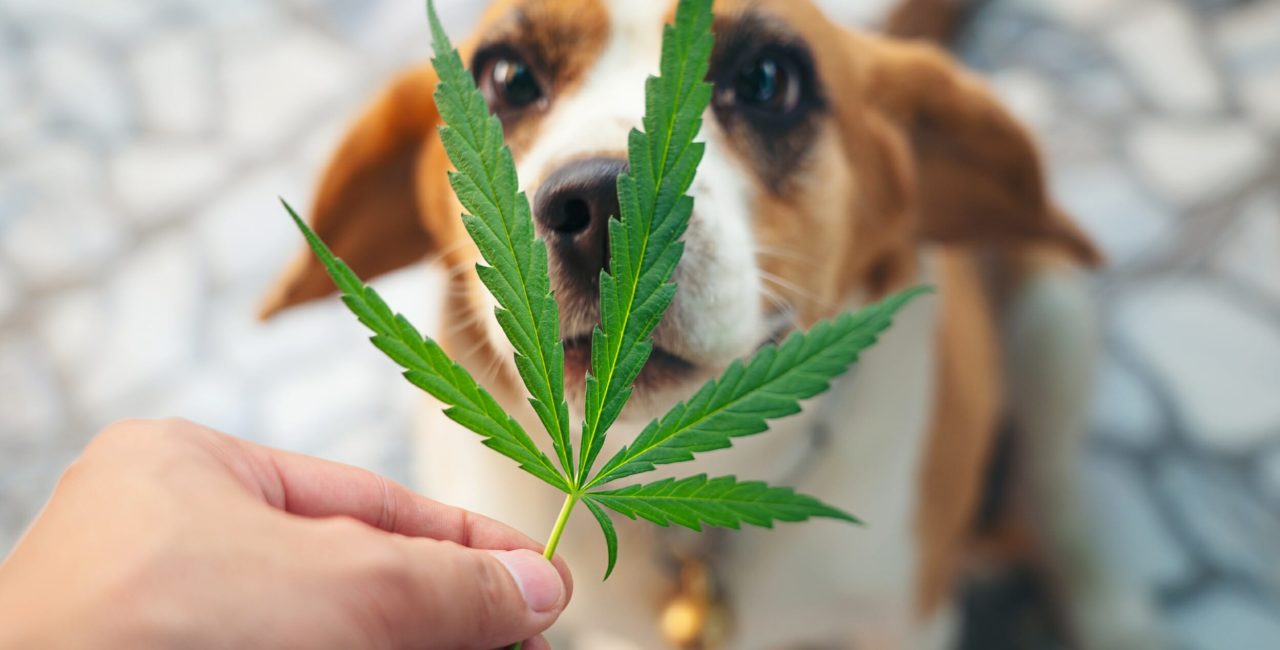Pets have more cannabinoid receptors in their brains than humans. This means that the effects of cannabis are more dramatic and potentially more toxic. A small amount of cannabis is all it takes to cause toxicity in cats and dogs.
Cannabis (or marijuana) refers to the dried parts of the Cannabis plant.
Cannabis contains more than 100 different compounds called cannabinoids. Tetrahydrocannabinol (THC) is the cannabinoid that has the most psychoactive effects and is the compound responsible for some of cannabis’ medicinal uses, (e.g., treating nausea and improving appetite in cancer patients). Other compounds, such as cannabidiol (CBD), have shown promise for medicinal use and do not have psychoactive effects.
“The increased accessibility to the drug has led to an increase in accidental exposure in pets.”
In the 1990s, individual states began legalizing cannabis for medicinal use, and more recently, 15 states and Washington, DC have legalized it for all use (medicinal and recreational), and another 18 states have legalized it for medicinal use. Legalization for recreational use in Canada occurred in 2018. As with any other medication, the increased accessibility to the drug has led to an increase in accidental exposure in pets.
How do cats and dogs become intoxicated?
Cats and dogs can become intoxicated by cannabis in various ways; by inhaling second-hand smoke, eating edibles (baked goods, candies, chocolate bars, and chips containing cannabis), or ingesting cannabis directly (in any form). Most exposures are accidental when curious pets discover access to the drug or when they are present in the same room with a person smoking cannabis. Dogs have more cannabinoid receptors in their brains, which means the effects of cannabis are more dramatic and potentially more toxic when compared to humans. A small amount of cannabis is all it takes to cause toxicity in cats and dogs. Regardless of the method of exposure, accurate and complete information is imperative to successfully treat the pet.
How does cannabis affect cats and dogs?
Like most drugs, the effects of cannabis are based on chemistry. The drug enters the body via inhalation or ingestion and binds with specific neuroreceptors in the brain, altering normal neurotransmitter function. Everything that enters the body has to exit. THC is easily stored in the fatty tissue in the liver, brain, and kidneys before being eliminated from the body. THC is metabolized in the liver and the majority (65-90%) is excreted in the feces, while a small percentage (10-35%) is eliminated through the kidneys. The drug must be metabolized and excreted for the effects to wear off.
How toxic is cannabis?
Cannabis is considered to have a high margin of safety for people; however, not all people, and certainly not all pets follow a single pattern of intoxication. A small amount may affect one pet more than another, so there is no official safe level of exposure. Differences in age, health status, and body size are some of the factors that can lead to toxicity differences. The minimum lethal oral dose of THC in pets is fairly high; however, deaths have been noted after ingestion of foods containing highly concentrated cannabis, such as medical-grade THC. In fact, fatalities were very rare until the development of medical-grade products.
What are the signs of cannabis intoxication?
Many of the signs of intoxication are neurological. Pets may become wobbly and uncoordinated. They may be hyperactive, disoriented, and very vocal. Their pupils may dilate, giving them a wild-eyed appearance, and they may drool excessively or vomit. They may also develop urinary incontinence (i.e., urine leakage). In severe cases, tremors, seizures, and coma can result. Physical signs include low or elevated heart rate and blood pressure and slowed respiration rate (breathing rate). Lethargy, and increases or decreases in body temperature may also be observed. Fortunately, these side effects are usually short- lived, but they can still be dangerous and make the pet quite miserable.
How is intoxication diagnosed?
Diagnosis is based on an accurate history and clinical signs. Although there are tests to determine the level of THC in the urine, the results take time, making them impractical. The diagnosis is made much more quickly, and treatment initiated, when responsible pet owners provide accurate information regarding the pet’s exposure.
How is intoxication treated?
When a toxin enters the body, often the first line of defense is to get it out. If the toxicity is discovered shortly after ingestion, your veterinarian may induce vomiting to prevent further absorption of the toxin. Two factors may interfere with this early defensive strategy. First, the signs of toxicity may manifest only after the drug has been absorbed, meaning it is already in the system. Second, cannabis has an anti-emetic effect which inhibits vomiting. In life-threatening cases, the stomach may be pumped (gastric lavage). Activated charcoal may be administered every 6-8 hours to neutralize the toxin. Enemas are also used to reduce toxin absorption from the gastrointestinal tract.
“Activated charcoal may be administered every 6-8 hours to neutralize the toxin.”
The second line of defense in cannabis toxicity, if needed, involves the use of medications and supportive care to regulate the pet’s heart rate, respiration, and body temperature until the effects of the drug wear off. Intravenous fluids can help prevent dehydration, support blood pressure, and maintain organ function. Anti-anxiety medications can minimize agitation. Confinement in a safe, comfortable space is helpful. Noise should be kept to a minimum to decrease sensory stimulation.
The Bottom Line
The bottom line, when it comes to cannabis use and pets, is similar to that with other drugs in the home: be careful. Keep all forms of cannabis, medical or recreational, out of reach of your pet. Consider storage in high cabinets or in locked drawers when not in use. Keep pets in a separate and well-ventilated room, away from second-hand smoke. Remember that pets have a good sense of smell and will be tempted to eat candies, chips, chocolates, and cannabis directly if accessible. If you notice suspicious behavior in your cat or dog and cannabis exposure is a possibility, take your pet to your veterinarian or the nearest emergency veterinary hospital for treatment.
View infographic on how to Avoid Cannabis Poisoning in Pets.
Contributors: Rania Gollakner, BS, DVM, MPH; Lynn Buzhardt, DVM
© Copyright 2021 LifeLearn Inc. Used and/or modified with permission under license.




